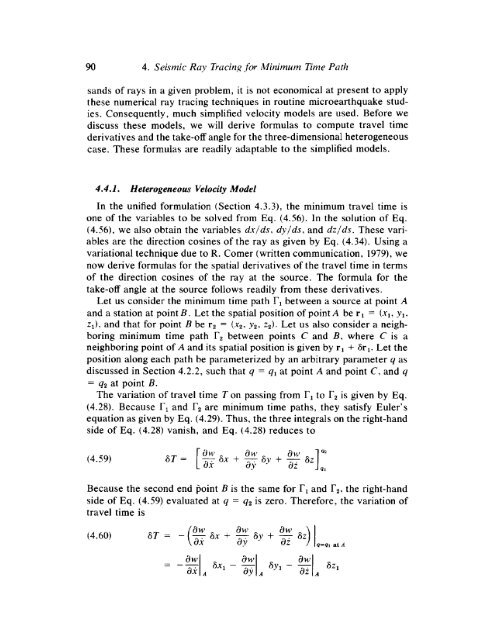principles and applications of microearthquake networks
principles and applications of microearthquake networks
principles and applications of microearthquake networks
You also want an ePaper? Increase the reach of your titles
YUMPU automatically turns print PDFs into web optimized ePapers that Google loves.
90 4. Seismic Ray Trucing .for Minimum Time Path<br />
s<strong>and</strong>s <strong>of</strong> rays in a given problem, it is not economical at present to apply<br />
these numerical ray tracing techniques in routine <strong>microearthquake</strong> studies.<br />
Consequently, much simplified velocity models are used. Before we<br />
discuss these models, we will derive formulas to compute travel time<br />
derivatives <strong>and</strong> the take-<strong>of</strong>f angle for the three-dimensional heterogeneous<br />
case. These formulas are readily adaptable to the simplified models.<br />
4.4.1. Heterogeneous Velocity Model<br />
In the unified formulation (Section 4.3.3), the minimum travel time is<br />
one <strong>of</strong> the variables to be solved from Eq. (4.56). In the solution <strong>of</strong> Eq.<br />
(4.56), we also obtain the variables d.u/ds, dylds, <strong>and</strong> dzlds. These variables<br />
are the direction cosines <strong>of</strong> the ray as given by Eq. (4.34). Using a<br />
variational technique due to R. Comer (written communication, 1979), we<br />
now derive formulas for the spatial derivatives <strong>of</strong> the travel time in terms<br />
<strong>of</strong> the direction cosines <strong>of</strong> the ray at the source. The formula for the<br />
take-<strong>of</strong>f angle at the source follows readily from these derivatives.<br />
Let us consider the minimum time path rl between a source at point A<br />
<strong>and</strong> a station at point B. Let the spatial position <strong>of</strong> point A be rl = (x1, y,,<br />
zl), <strong>and</strong> that for point B be r2 = (x2. y,, 2,). Let us also consider a neighboring<br />
minimum time path r2 between points C <strong>and</strong> B, where C is a<br />
neighboring point <strong>of</strong> A <strong>and</strong> its spatial position is given by rl + 6r,. Let the<br />
position along each path be parameterized by an arbitrary parameter q as<br />
discussed in Section 4.2.2, such that q = q1 at point A <strong>and</strong> point C, <strong>and</strong> q<br />
= q2 at point B.<br />
The variation <strong>of</strong> travel time Ton passing from rl to r2 is given by Eq.<br />
(4.28). Because F1 <strong>and</strong> T2 are minimum time paths, they satisfy Euler’s<br />
equation as given by Eq. (4.29). Thus, the three integrals on the right-h<strong>and</strong><br />
side <strong>of</strong> Eq. (4.28) vanish, <strong>and</strong> Eq. (4.28) reduces to<br />
(4.59)<br />
Because the second end point B is the same for rl <strong>and</strong> T2, the right-h<strong>and</strong><br />
side <strong>of</strong> Eq. (4.59) evaluated at q = q2 is zero. Therefore, the variation <strong>of</strong><br />
travel time is






